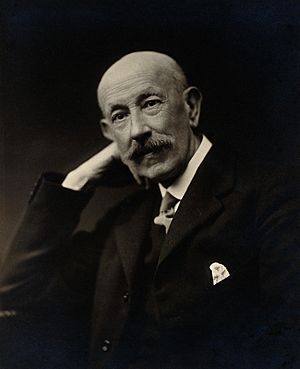Frederick William Andrewes facts for kids
Sir Frederick William Andrewes (31 March 1859 – 24 February 1932) was a very important British doctor. He was a physician, which means he treated patients. He was also a pathologist, someone who studies diseases. And he was a bacteriologist, meaning he studied tiny living things called bacteria.
Contents
Early Life and Education
Frederick Andrewes was born in Reading, Berkshire, in 1859. He went to Oakley House School. Later, in 1878, he started studying at Christ Church, Oxford University. He did very well, earning top honors in natural sciences.
He then received a special scholarship in Geology. In 1885, he began his medical training at St Bartholomew's Hospital Medical College. There, he learned about bacteria from Emanuel Edward Klein. He also studied diseases from Alfred Antunes Kanthack.
A Career in Medicine
After finishing his studies, Andrewes worked at St Bartholomew's Hospital. He also spent some time studying in Vienna. When he came back, he became a doctor at St Bartholomew's. He also taught practical medicine to other students.
He worked as a doctor and pathologist at the Royal Free Hospital. A pathologist is a scientist who studies diseases. They look at tissues and samples to understand what causes illness.
In 1897, he became the main pathologist and lecturer at St Bartholomew's Hospital. He held these important jobs for 30 years. In 1912, his teaching role was made into a full professorship by the University of London.
Important Discoveries
Sir Frederick Andrewes did a lot of research. He studied how to group different types of streptococci. These are a common type of bacteria. He was one of the first to classify them into three main groups. This helped doctors understand and treat infections better.
He also studied how the body's immune system works. This is how our bodies fight off sickness. He looked at how arteries, which are blood vessels, can become damaged.
Work During World War I
Sir Frederick Andrewes was a member of the Medical Research Council. This group helps guide medical research. During World War I (1914-1918), he did very important work. He studied the bacteria that cause dysentery. This was a serious disease that affected many soldiers. His work helped to control the spread of this illness.
Family Life
In 1895, Frederick Andrewes married Phyllis Mary Hamer in London. They had a son named Christopher Andrewes. Their son also became a famous scientist. They also had a daughter.
Awards and Honours
Sir Frederick Andrewes received many awards for his important work:
- 1895 — He became a Fellow of the Royal College of Physicians (FRCP).
- 1906 — He gave the Dobell Lecture.
- 1910 — He gave the Croonian Lecture for the Royal College of Physicians.
- 1915 — He became a Fellow of the Royal Society (FRS). This is a very high honor for scientists.
- 1919 — He received the Order of the British Empire (OBE).
- 1920 — He gave the Harveian Oration, a famous medical lecture.
- 1920 — He was given a knighthood, so he became "Sir Frederick."


